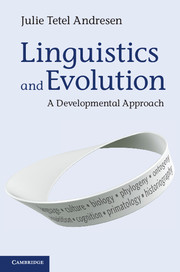Book contents
- Frontmatter
- Contents
- List of Figures
- Introduction Historiography’s contribution to theoretical linguistics
- Part I Theoretical considerations
- Part II A developmental systems linguistics
- Part III What to do next
- 8 Revisit: Skinner, Chomsky and construction grammar
- 9 Revise: introductory linguistics textbooks
- Bibliography
- Name index
- Subject index
8 - Revisit: Skinner, Chomsky and construction grammar
Published online by Cambridge University Press: 05 June 2014
- Frontmatter
- Contents
- List of Figures
- Introduction Historiography’s contribution to theoretical linguistics
- Part I Theoretical considerations
- Part II A developmental systems linguistics
- Part III What to do next
- 8 Revisit: Skinner, Chomsky and construction grammar
- 9 Revise: introductory linguistics textbooks
- Bibliography
- Name index
- Subject index
Summary
One of the most fascinating episodes in the relatively recent history of linguistics involves the publication of Verbal Behavior by the American behaviorist psychologist B. F. Skinner in 1957 and Chomsky’s review of it that appeared in the Linguistic Society of America’s main journal Language in 1959. A less circumspect way of describing this episode is to say that Chomsky’s review of Verbal Behavior caused a theoretical and methodological trauma in linguistics from which the discipline is still recovering. In short, Chomsky (1959) had the immediate effect of exiling the consideration of the circumstances that contribute to the production of any given utterance from so-called hard-core linguistic research, thereby keeping so-called sociolinguistics and discourse analysis on the soft sidelines for many years and the tradition of languaging as an orienting behavior completely out of bounds. One purpose of this chapter is to reattach the piece that Chomsky broke off, so that we can move on from a new whole.
At the time Chomsky wrote his review, he had published his first monograph Syntactic Structures only two years earlier and was a relative newcomer to the field, while the well-published Skinner was undoubtedly the most well-known American psychologist of the era, behaviorist or otherwise. With his review, Chomsky made an almost instant name for himself in linguistic circles as the champion of the new rationalism and innatism. He succeeded not only in creating the impression that he had completely dismantled Skinner’s account but also in demonizing the man and his lifework in the linguistic community. The disparagement and misrepresentation of Skinner’s work lives on. Take, for instance, Foundations of Language: Brain, Meaning, Grammar, Evolution by Ray Jackendoff, who is interested to acknowledge the contributions of numerous non-transformational approaches to generative grammar that developed during the 1980s and 1990s and to integrate them into a reformulated account of the field for the twenty-first century.
- Type
- Chapter
- Information
- Linguistics and EvolutionA Developmental Approach, pp. 229 - 259Publisher: Cambridge University PressPrint publication year: 2013

